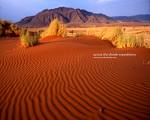
 I feel I need to say something; the grating sound’s getting louder by the minute. Is there anything wrong with the engine? I ask as casually as I can. I’m squashed against the door of the Land Rover. We’re grinding to a halt, at an acute angle, half way up a sand dune.
I feel I need to say something; the grating sound’s getting louder by the minute. Is there anything wrong with the engine? I ask as casually as I can. I’m squashed against the door of the Land Rover. We’re grinding to a halt, at an acute angle, half way up a sand dune.Our guide, Bariar Tugendapi, chuckles. Apparently he always sees the funny side of things. His hand reaches for a lower gear then realises there isn’t one.
“Oops,” he remarks, his eyes sparkling. “A problem with the engine you say?” He mulls it over. “Well it wouldn’t be the first time, but that, that grinding sound, that’s sand rattling round the brake system.”
I look alarmed. “Oh don’t worry. It’s only a problem if we want to stop. But at a time like this, it’s best to keep moving; forward, back, sideways, whatever. If we stop we’re really in trouble.”
His face breaks into a grin. Although it’s clear Bariar isn’t bothered, I’d prefer it if we were more in control. We’ve set off on a 200 mile daytrip to one of the bleakest coastlines in the world — which I admit already sounds a little ridiculous — and now we’re at the mercy of shifting sand.
I’d arrived at Skeleton Coast in Namibia the day before, flying in with a couple of others — a full plane. Our camp, six tents set on a dry river bed, caters for twelve. Visitors are restricted to just 800 a year to protect one of the world’s most fragile environments.
As we flew in I watched musty green waves break ferociously onto a brown shoreline. Beyond, there was nothing but sand — an expanse of curved patterns and gentle ridges, as if the waves had just withdrawn and were about to wash over again. The colours were magical; golds, browns, russets and shades of grey with a hint of purple.
The wheels of the car squeal. We lurch forward. The stark line separating the dune from the brilliant blue sky levels itself. Bariar is back in business.
We carve our way through the Namib. The landscape’s five million years old, yet it seems like we’re its first discoverers. Ours are the only tyre marks; yellow stripes meandering round gravel plains and rare lichens. We pass mounds of pale orange sand, blown by the wind. It’s as if tiny graves have been scattered over the desert, each with its own flowers.
Without compass or Sat Nav, Bariar follows a route I can’t make out. He suggests I look for the odd “unexpected stone,” placed as an indication to turn left or right or double back a touch. Our path reminds us we’re guests in a delicate ecosystem.
Finally we reach the coast. Here the suffocating heat of the Namib meets its rival in the freezing Atlantic, its cross currents crashing in over rocky outcrops, hidden reefs and treacherous sandbanks. Portuguese sailors once called it the gates of Hell. Bushmen in central Namibia still speak of the land God made in anger.
I climb out of the car into a massive graveyard. The shore is littered with the bones of whales, seals and turtles. The wind shunts me from one set of remains to the next.
“And human skeletons?” I ask, shouting at Bariar. The stark reality of the place releases me from inhibition.“Of course!” he shouts back, “It’s the place of a thousand shipwrecks.” His voice is lost in the wind.
Later he tells how the British liner the Dunedin Star ran aground during World War 2, packed with munitions and passengers. A tug, the Sir Charles Elliott went to her aid but sank off Rocky Point. We crouch over the simple, stone grave of two crewmen who tried to coordinate the rescue effort. They got a rope from the liner to the shore, but collapsed soon after.
We leave the windblown seabirds and scuttling orange ghost crabs and follow the shoreline for miles. Pied crows scatter as we pass. A jackal stops gambolling and flops onto the sand. The air is thick with spray. For much of the year the coast’s shrouded in dense fog.
At Cape Frio, fur seals, ten thousand of them, provide light relief. Their noise and smell is almost overwhelming, but their antics draw us close. The surf is full of black splodges. Occasionally a rock twitches, rolls over and throws itself into the sea.
The next couple of days are spent closer to camp, hiking through gorges, marvelling at a chameleon which sat blinking onto a hand, and spotting a tok-tokkie beetle sitting on top of his friend, to provide shade.
As we enjoy our surroundings there’s a deeper awareness of the importance of conservation. We learn that our camp has no fences so animals can roam where they please. Neither are there permanent buildings which would have disturbed the land. Wilderness Safaris which runs the operation has won awards for its green credentials, and works hard for them.
Karen Bowerman is a reporter and producer for fast:track, BBC World News’ travel and travel news programme.

Be the first to comment